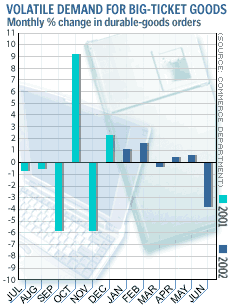NEW YORK (CNN/Money) - Demand for durable goods made in U.S. factories plunged in June, the government said Thursday, hinting that the manufacturing sector's recovery from a long slump may have stalled.
The Commerce Department reported that orders for goods made to last three years or longer, such as cars and computers, fell 3.8 percent to $166.6 billion following a 0.6 percent gain in May. Economists expected durable-goods orders to rise 0.5 percent, according to Briefing.com.
It was the biggest drop in durable goods orders since a 5.9 percent drop in November 2001, though economists hastened to point out that the report is usually volatile.
"You have to look at these numbers over a few months. Coming in, we had several months of very substantial gains," Joshua Feinman, chief economist at Deutsche Bank Asset Management, told CNNfn's CNNmoney Morning program. "The basic picture is that business spending is bottoming and showing some signs of improvement, but it's not really robust."

Separately, the National Association of Realtors said existing home sales fell 11.7 percent to an annual rate of 5.07 million units in June from 5.75 million units in May. Economists surveyed by Briefing.com expected sales at a rate of 5.75 million units.
And the Commerce Department said new home sales rose 0.5 percent to a 1 million-unit annual rate in June, compared with May's revised 996,000-unit pace. Economists surveyed by Briefing.com expected the pace of new-home sales to fall to 980,000.
In another report, the Labor Department said the number of Americans filing new claims for unemployment benefits fell to 362,000 in the week ended July 20 from a revised 383,000 the prior week. Economists, on average, expected 385,000 new claims, according to Briefing.com.
It was the lowest number of weekly jobless claims in 17 months -- a hopeful sign that the labor market, which shed 1.5 million jobs during a recession that began in March 2001, is slowly recovering.
U.S. stock prices fell in afternoon trading, while Treasury bond prices rose.
Treasury Secretary Paul O'Neill, speaking to the National Association of Manufacturers, tried to reassure investors that the economy remained unaffected by the recent volatility in stock prices, which have been driven sharply lower by fears about the reliability of corporate accounting.
"In our history we have seen times when there is a disconnect between the stock market and the fundamental productive power of our economy," O'Neill said. "The reality is that our economy remains solid, and our recovery is well under way."
But economists have worried that widespread stock losses could cause consumers to lose confidence and stop spending, which would be disastrous for the economy, since consumer spending makes up about two-thirds of all U.S. economic activity.
Consumers have been buoyed throughout the recent economic and market turmoil by a red-hot housing market, which itself was supported by rock-bottom mortgage rates. Lower rates have pumped up demand for houses, pushing home values higher and making consumers feel wealthier. Lower rates have also encouraged a glut of refinancing, which has put more cash in consumers' pockets.
June's dive in durable goods orders was led by a 5.6 percent drop in demand for transportation equipment. Excluding transportation goods, total orders fell 3.1 percent. Excluding defense orders -- the only sector posting gains -- total orders fell 4.8 percent.
Orders for machinery plunged 6.7 percent, and non-defense capital goods orders -- which Feinman noted were a direct reflection of business investment -- dived 8.5 percent. Excluding airplanes, non-defense capital goods orders fell 5.2 percent.
In the Labor Department report, the four-week moving average of new jobless claims, which smoothes out fluctuations in the weekly data, fell to 384,500 last week from a revised 392,000 in the prior week.
Continued claims, the number of people drawing benefits for more than a week, fell to 3.52 million in the week ended July 13, the latest data available, from a revised 3.57 million in the prior week.

|

